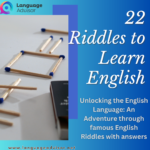ESCAPE THE CREEPY TOWN – Teaching English with Halloween-Themed Riddles: A Fun and Spooky Approach. Free printable PDF and free Video
ESCAPE THE CREEPY TOWN – Halloween Riddles

Halloween is the perfect time to add a bit of spooky fun to your English lessons. One creative and engaging way to introduce language skills to young learners is by using Halloween-themed riddles. Riddles are excellent for building critical thinking, improving listening and comprehension, and expanding vocabulary, all while keeping students entertained. With the mysterious and playful spirit of Halloween, riddles can become a fantastic tool for making English learning fun and memorable.
1. Why Use Riddles in Language Learning?
Riddles challenge students to think beyond the obvious and listen carefully to the clues provided. They stimulate curiosity, encourage problem-solving, and create a fun atmosphere where students want to participate. Here’s how Halloween-themed riddles can benefit your students:
- Improved Vocabulary: Riddles introduce new words in an interesting context, helping students to remember them better.
- Listening and Comprehension Skills: To solve a riddle, students must pay close attention to the language being used, improving their listening skills.
- Critical Thinking: Riddles challenge students to think creatively, making connections between the clues and the answer.
- Speaking Practice: Students can practice asking and answering riddles, which promotes conversation and active engagement in the classroom.
2. Introducing Halloween-Themed Riddles
Start your lesson by introducing simple Halloween vocabulary (ghost, pumpkin, skeleton, bat, etc.) to set the tone. Once students are familiar with the words, introduce some easy Halloween-themed riddles to get them thinking.
Here are a few fun examples:
- Riddle 1: “I am tall when I’m young, and short when I’m old. What am I?”
(Answer: A candle.) - Riddle 2: “I have no legs, I have no arms, but I can crawl and move. What am I?”
(Answer: A snake.) - Riddle 3: “I am orange, round, and I have a smile, but only in October for a short while. What am I?”
(Answer: A jack-o’-lantern.)
These types of riddles allow students to apply their knowledge of Halloween vocabulary while making learning interactive and fun.
3. Games and Activities with Halloween Riddles
To fully engage students, turn Halloween riddles into classroom games and activities. Here are a few ideas that can spark creativity and excitement:
Riddle Relay
Divide the class into two teams and set up a riddle relay. Each team must solve a riddle before moving on to the next one. The team that answers the most riddles correctly wins. This game encourages teamwork, competition, and communication in English.
Guess the Riddle
Write several Halloween riddles on the board. Have students work in pairs or small groups to figure out the answers. After they’ve guessed, go over the riddles as a class and have the groups share their answers. You can add a challenge by offering a small Halloween-themed prize for the group that solves the most riddles correctly.
Create Your Own Riddles
Encourage students to come up with their own Halloween-themed riddles. This activity helps them think critically about wordplay and language structure while being creative. Students can share their riddles with the class, and their peers can try to solve them. This not only reinforces vocabulary but also gives students a chance to practice speaking and presenting.
Riddle Scavenger Hunt
Turn your classroom into a spooky scavenger hunt. Hide Halloween-themed objects around the room (like a mini pumpkin, a toy bat, or a witch’s hat), and create riddles that lead students to these items. For example, “I’m black, I fly at night, and I make no sound when I take flight. What am I?” (Answer: A bat). Each time students solve a riddle, they must find the corresponding object. This activity combines physical movement with language learning, making it even more engaging.
4. Incorporating Riddles into Speaking and Listening Activities
Halloween riddles naturally lend themselves to listening and speaking practice. You can use them to encourage students to listen attentively and respond in English. Here are a few ideas:
- Riddle Partners: Pair students and have them take turns reading riddles aloud. The other student listens and tries to guess the answer. This helps both the reader and the listener improve their language skills.
- Class Discussion: After solving a riddle, ask students to explain how they came to their answer. This promotes speaking skills and helps them articulate their thought processes.
- Riddle of the Day: Every day leading up to Halloween, present a “Riddle of the Day.” Have students discuss the possible answers in small groups and present their ideas to the class. This encourages collaboration and speaking practice.
5. Using Riddles to Teach Grammar and Sentence Structure
Riddles can also be a great way to focus on grammar and sentence structure. You can highlight how the sentences in riddles are constructed and ask students to break down the grammar. For instance, many riddles use conditionals or descriptive adjectives, so this could be a fun way to sneak in some grammar lessons while keeping the focus on solving puzzles.
For example, you can focus on the use of “I am” and “What am I?” in riddles to teach students how to describe something without giving away the answer too quickly. This also helps students think about how they can use similar sentence structures in their everyday English conversations.
6. Wrap Up with a Halloween Riddle Challenge
To conclude your Halloween-themed riddle lesson, host a class-wide “Halloween Riddle Challenge.” Prepare a set of riddles and give each student a turn to solve one. If they solve it correctly, they can win a small treat or a sticker. This final activity brings the lesson to a fun and festive close, leaving students excited about what they’ve learned.
Conclusion
Using Halloween-themed riddles to teach English not only makes learning enjoyable but also helps students develop important language skills in a playful, relaxed environment. Riddles foster critical thinking, encourage active participation, and boost both vocabulary and grammar knowledge.
Incorporating riddles into your Halloween lessons adds an element of fun that can make your students more eager to learn. With creative activities and games, your students will practice speaking, listening, and problem-solving, all while enjoying the spooky season. So get ready to share some riddles and let the Halloween fun begin! 🎃

ESCAPE THE CREEPY TOWN

DOWNLOAD THE PDF FOR FREE






